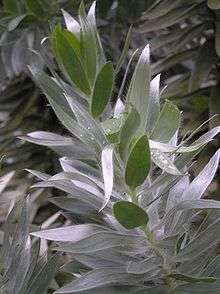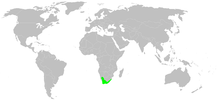Leucadendron
| Leucadendron | |
|---|---|
 | |
| Leucadendron argenteum | |
| Scientific classification | |
| Kingdom: | Plantae |
| (unranked): | Angiosperms |
| (unranked): | Eudicots |
| Order: | Proteales |
| Family: | Proteaceae |
| Genus: | Leucadendron R.Br. |
 | |
| Natural range of the genus | |

Leucadendron is a genus of about 80 species of flowering plants in the family Proteaceae, endemic to South Africa, where they are a prominent part of the fynbos ecoregion and vegetation type.
Description
Species in the genus Leucadendron are small trees or shrubs that are erect or creeping.[1] Most species are shrubs that grow up to 1 m tall, some to 2 or 3 m. A few grow into moderate-sized trees up to 16 m tall. All are evergreen. The leaves are largely elliptical, sometimes needle-like, spirally arranged, simple, entire, and usually green, often covered with a waxy bloom, and in the case of the Silvertree, with a distinct silvery tone produced by dense, straight, silky hairs. This inspired the generic name Leucadendron, which literally means "white tree".
The flowers are produced in dense inflorescences at the branch tips; plants are dioecious, with separate male and female plants.
The seed heads, or infructescences, of Leucadendron are woody cone-like structures. This gave rise to their generic common name cone-bush. The cones contain numerous seeds. The seed morphology is varied and reflects subgeneric groupings within the genus. A few such as the Silvertree, Leucadendron argenteum have a silky-haired parachute, enabling the large round nut to be dispersed by wind. A few are rodent dispersed, cached by rats, and a few have elaiosomes and are dispersed by ants. About half the species store the seeds in fire-proof cones and release them only after a fire has killed the plant or at least the branch bearing the cone. Many such species hardly recruit naturally except after fires.
Cultivation
Leucadendron plants are conventionally propagated through seedlings as well as cuttings. The seeds reach maturity over a duration of a year. This time of germination and emergence depends on the type of Leucadendron genus. When using cuttings as propagating material, the season as well as the type of material used can affect the success rate of the cultivation. Cuttings are preferred as propagating material, because it provides uniform offspring whereas seedlings produces genetic variability in the offspring. The Leucadendron genus are more prone to genetic variation than a genus that tend to self-fertilize, because of their cross-pollinating nature. In the natural habitat the Leucadendron grows exceptionally well, but in the case of cultivation the specific needs of the plant has to be readily available to allow optimal production to produce high quality cut flowers and foliage. Steps for cultivation include soil evaluation, clearing, drainage, chemical correction, and the physical preparation should be critically considered five months prior to planting Leucadendrons.[2] The selection criteria for cultivating Leucadendron genera is of great importance and should be based on the agricultural ability of the plant as well as the current market standards.
Selected species
- Leucadendron album
- Leucadendron arcuatum
- Leucadendron argenteum
- Leucadendron barkerae
- Leucadendron bonum
- Leucadendron brunioides
- Leucadendron burchellii
- Leucadendron cadens
- Leucadendron chamelaea
- Leucadendron cinereum
- Leucadendron comosum
- Leucadendron concavum
- Leucadendron conicum
- Leucadendron coniferum
- Leucadendron cordatum
- Leucadendron coriaceum
- Leucadendron corymbosum
- Leucadendron cryptocephalum
- Leucadendron daphnoides
- Leucadendron diemontianum
- Leucadendron discolor
- Leucadendron dregei
- Leucadendron dubium
- Leucadendron elimense
- Leucadendron ericifolium
- Leucadendron eucalyptifolium
- Leucadendron flexuosum
- Leucadendron floridum
- Leucadendron foedum
- Leucadendron galpinii
- Leucadendron gandogeri
- Leucadendron glaberrimum
- Leucadendron globosum
- Leucadendron grandiflorum
- Leucadendron gydoense
- Leucadendron immoderatum
- Leucadendron lanigerum
- Leucadendron laureolum
- Leucadendron laxum
- Leucadendron levisanus
- Leucadendron linifolium
- Leucadendron loeriense
- Leucadendron loranthifolium
- Leucadendron macowanii
- Leucadendron meridianum
- Leucadendron meyerianum
- Leucadendron microcephalum
- Leucadendron modestum
- Leucadendron muirii
- Leucadendron nervosum
- Leucadendron nitidum
- Leucadendron nobile
- Leucadendron olens
- Leucadendron orientale
- Leucadendron osbornei
- Leucadendron platyspermum
- Leucadendron pondoense
- Leucadendron procerum
- Leucadendron pubescens
- Leucadendron pubibracteolatum
- Leucadendron radiatum
- Leucadendron remotum
- Leucadendron roodii
- Leucadendron rourkei
- Leucadendron rubrum
- Leucadendron salicifolium
- Leucadendron salignum
- Leucadendron sericeum
- Leucadendron sessile
- Leucadendron sheilae
- Leucadendron singulare
- Leucadendron sorocephalodes
- Leucadendron spirale
- Leucadendron spissifolium
- Leucadendron stellare
- Leucadendron stelligerum
- Leucadendron strobilinum
- Leucadendron teretifolium
- Leucadendron thymifolium
- Leucadendron tinctum
- Leucadendron tradouwense
- Leucadendron uliginosum
- Leucadendron verticillatum
- Leucadendron xanthoconus
Hybridization
The drive behind the production of new Leucadendron cultivars is the production of a constant supply of new and improvedd quality products that are available initially from South Africa only.[3] The Leucadendron genus is common amongst consumers due to its colourful bracts and long lasting vase life. Leucadendron hybrids are produced through interspecific hybridization.[4] Crosses made within the same subsection are generally more viable in the hybridization of Leucadendrons with the quantity of seed set relative to the taxonomic relatedness of the species. Intersectional hybridization produces hybrids that show a unique set of characteristics which are favoured by consumers. One example of a hybrid produced by two Leucadendron genuses is the cultivar Rosette, a hybrid between L. laureolum and L. elimense. This interspecific hybrid is however completely sterile due to autopolyploidy and thus have no use in further cultivation. The main aim of interspecific hybridization is to produce large quantities of progeny seed from the best interspecific hybrid parents.[5]
References
- ↑ Manning, John; Paterson-Jones, Colin (2008). Field Guide to Fynbos. Struik Publishers, Cape Town. p. 254. ISBN 978-1-77007-265-7.
- ↑ (Malan, G. Protea Cultivation from concept to carton. page: 80. 2012. ISBN 978-0-620-55300-1)
- ↑ (Littlejohn, G.M. (2002). Breeding Technology for Protea. Fynbos Research. Page 2)
- ↑ (Croxford, Yan and Sedgley, 2003)
- ↑ (Littlejohn, G.M. (2002). Breeding Technology for Protea. Fynbos Research. Page 2)
External links
 Media related to Leucadendron at Wikimedia Commons
Media related to Leucadendron at Wikimedia Commons